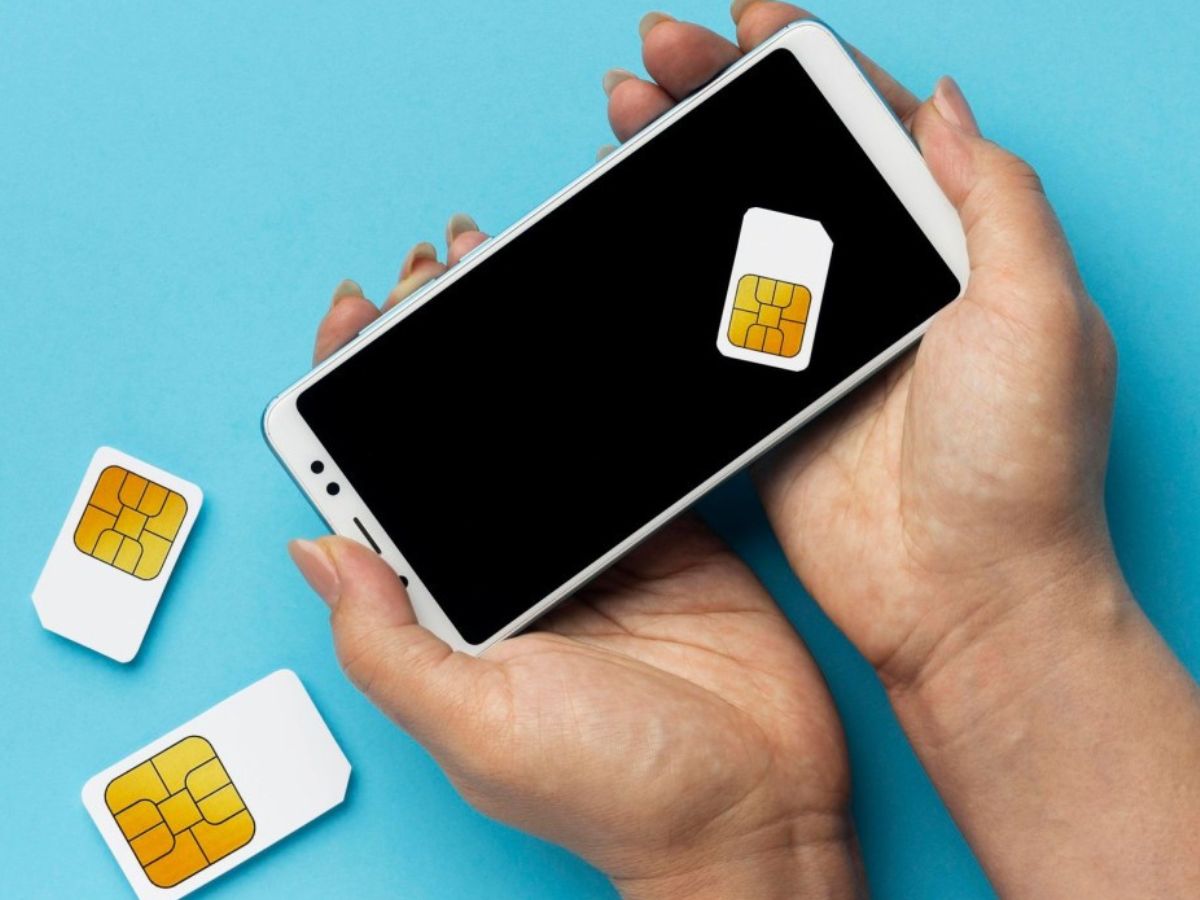Introduction
In today's fast-paced digital age, our mobile devices have become an indispensable part of our lives. From staying connected with loved ones to managing work-related communications, our smartphones play a crucial role in facilitating seamless and instant communication. One of the most vital components within our mobile devices is the Subscriber Identity Module (SIM) card, which not only enables us to connect to a network but also serves as a storage unit for various data, including text messages.
Understanding the significance of text messages in our daily interactions is essential. These messages often contain valuable information, cherished memories, and crucial details that we may need to access at a later time. However, the storage capacity of our smartphones may be limited, leading to concerns about managing and preserving these significant text messages effectively.
In this comprehensive guide, we will delve into the world of SIM card storage and explore the benefits and limitations of saving text messages on a SIM card. Furthermore, we will provide step-by-step instructions on how to save text messages on a SIM card, along with useful tips for efficiently managing this data. By the end of this guide, you will have a clear understanding of the potential advantages and considerations associated with utilizing your SIM card as a storage solution for text messages.
As we embark on this journey, it's important to recognize the evolving landscape of mobile communication and the pivotal role that our SIM cards play in preserving our digital correspondence. Let's unravel the intricacies of saving text messages on a SIM card and discover the practical methods and best practices for leveraging this storage option effectively.
Understanding SIM Card Storage
The Subscriber Identity Module (SIM) card, a small but mighty component nestled within our mobile devices, serves as a vital repository for various types of data, including text messages. Its primary function is to authenticate our identity and enable connectivity to a mobile network, but its storage capabilities extend beyond mere authentication.
SIM cards are equipped with a specific amount of memory, typically measured in kilobytes (KB) or megabytes (MB), which varies depending on the card's type and manufacturer. This storage capacity allows the SIM card to retain essential information, such as contact details, network-specific configurations, and, notably, text messages.
When it comes to text message storage, the SIM card plays a crucial role in preserving these snippets of digital communication. Each text message, or SMS (Short Message Service), occupies a small portion of the SIM card's memory. This allocation allows the card to store a limited number of messages, depending on their length and the available memory space.
It's important to note that the storage capacity of a SIM card for text messages may be relatively modest compared to the expansive memory found in modern smartphones. As a result, the SIM card's ability to accommodate a large volume of text messages is constrained, making it essential to consider the implications of utilizing the SIM card as a storage solution.
Furthermore, SIM cards have evolved over the years, with newer iterations, such as the micro-SIM and nano-SIM, offering reduced physical dimensions while retaining or even increasing their storage capacities. These advancements have enabled SIM cards to continue serving as a reliable storage medium for text messages, despite their diminutive size.
Understanding the intricacies of SIM card storage provides valuable insights into the limitations and potential benefits associated with leveraging this storage option for text messages. As we delve deeper into this guide, we will explore the practical considerations and steps involved in effectively managing and preserving text messages on a SIM card. This knowledge will empower you to make informed decisions regarding the storage and organization of your digital communications within the confines of the SIM card's memory.
Benefits of Saving Text Messages on SIM Card
Saving text messages on a SIM card offers several compelling benefits that cater to the diverse needs of mobile users. Understanding these advantages can shed light on the practical implications of utilizing the SIM card as a storage solution for text messages.
-
Portability and Accessibility: By storing text messages on a SIM card, users can enjoy the portability of their messages across different mobile devices. This means that even if they switch to a new phone, their text messages stored on the SIM card can be readily accessed without the need for complex data transfers or backup procedures.
-
Security and Privacy: SIM cards are inherently secure, as they require a unique PIN code for access. This security feature extends to the stored text messages, offering a layer of privacy and protection against unauthorized access. For individuals who prioritize data security, saving text messages on a SIM card provides peace of mind regarding the confidentiality of their communications.
-
Backup Redundancy: In the event of smartphone malfunction or data loss, having text messages saved on a SIM card serves as a redundant backup. This redundancy ensures that important messages are preserved independently of the phone's internal storage, mitigating the risk of data loss due to unforeseen circumstances.
-
Compatibility and Interoperability: SIM cards are universally compatible with a wide range of mobile devices, regardless of brand or model. This interoperability ensures that text messages stored on a SIM card can be seamlessly transferred and accessed across different phones, offering a level of flexibility and convenience for users who frequently change or upgrade their devices.
-
Storage Optimization: For individuals with limited internal storage on their smartphones, offloading text messages to the SIM card can free up valuable space for other applications and media. This storage optimization allows users to maintain a clutter-free device while retaining access to their important text message conversations.
-
Offline Access: Storing text messages on a SIM card enables offline access to these messages, even in scenarios where the smartphone's internal memory is inaccessible. This can be particularly useful during emergencies or when encountering network connectivity issues, ensuring that critical information contained in the text messages remains readily available.
By leveraging these benefits, users can harness the potential of their SIM card as a reliable and versatile storage solution for preserving text messages. The inherent advantages of portability, security, compatibility, and backup redundancy make saving text messages on a SIM card a compelling choice for individuals seeking a convenient and resilient approach to managing their digital communications.
Limitations of Saving Text Messages on SIM Card
While the prospect of saving text messages on a SIM card presents numerous advantages, it is important to acknowledge the inherent limitations associated with this storage approach. Understanding these constraints is crucial for making informed decisions regarding the preservation and management of text messages within the confines of a SIM card's memory.
-
Limited Storage Capacity: SIM cards typically offer a relatively modest storage capacity for text messages compared to the expansive memory found in modern smartphones. This limitation translates to a finite number of messages that can be stored on the SIM card, restricting the long-term viability of this storage solution for individuals with high message volumes.
-
Message Length Restrictions: The storage of text messages on a SIM card is further constrained by limitations on message length. In some cases, particularly with older SIM card models, longer messages may be fragmented or truncated, leading to potential loss of context and coherence in the stored conversations.
-
Lack of Multimedia Support: Unlike the internal storage of smartphones, SIM cards are not designed to accommodate multimedia content within text messages. This means that images, videos, and other multimedia elements commonly exchanged in modern messaging platforms cannot be saved on a SIM card, limiting its suitability for comprehensive message preservation.
-
Compatibility with Advanced Messaging Features: With the evolution of messaging services and the introduction of advanced features such as read receipts, message reactions, and multimedia sharing, the basic storage capabilities of a SIM card may not fully support these modern communication functionalities. As a result, utilizing the SIM card for text message storage may lead to the loss of these enhanced messaging features.
-
Inconvenient Management: Accessing and managing text messages stored on a SIM card can be less intuitive and user-friendly compared to the native messaging interfaces of smartphones. This can pose challenges in organizing, searching, and retrieving specific messages, especially when dealing with a large volume of stored conversations.
-
Device Dependency: While the portability of text messages across different devices is a notable advantage, the reliance on a physical SIM card for message storage means that users are bound to the presence of the card in compatible devices. This dependency may limit the seamless accessibility of messages in scenarios where the SIM card is unavailable or incompatible with the device in use.
Understanding these limitations underscores the need for a balanced approach to text message storage, wherein the unique advantages of SIM card storage are weighed against the practical constraints. By recognizing these limitations, individuals can make informed decisions regarding the suitability of saving text messages on a SIM card based on their specific communication needs and preferences.
How to Save Text Messages on SIM Card
Saving text messages on a SIM card involves a straightforward process that varies slightly depending on the mobile device and messaging application used. While the specific steps may differ across devices, the fundamental approach to transferring and storing text messages on a SIM card remains consistent. Here's a comprehensive guide on how to save text messages on a SIM card:
Step 1: Access Messaging Settings
Begin by accessing the messaging settings on your mobile device. Depending on the device's operating system (e.g., Android, iOS) and the messaging app in use, the location of the settings menu may vary. Look for options related to message management, storage, or SIM card settings within the messaging application or the device's system settings.
Step 2: Select Messages for Transfer
Once in the messaging settings, identify the option to manage or transfer messages to the SIM card. This may involve selecting specific conversations, individual messages, or utilizing a bulk transfer feature to move multiple messages to the SIM card. Some devices may offer the ability to mark messages for transfer by using checkboxes or similar selection methods.
Step 3: Initiate Transfer to SIM Card
After selecting the desired messages, initiate the transfer process to save them on the SIM card. Depending on the device and messaging app, this action may be labeled as "Export to SIM" or "Save to SIM Card." Confirm the transfer and allow the device to complete the process of moving the selected messages to the SIM card's storage.
Step 4: Verify Transfer Completion
Once the transfer process is complete, verify that the selected text messages have been successfully saved on the SIM card. This can be done by accessing the SIM card's storage within the messaging settings or by reviewing the messaging app's options for managing messages stored on the SIM card.
Step 5: Manage and Organize Stored Messages
With the text messages successfully saved on the SIM card, consider organizing and managing the stored messages for easy access and retrieval. Some devices may offer options to categorize or archive SIM card messages, allowing for efficient navigation and retrieval of specific conversations when needed.
Step 6: Consider Message Length and Compatibility
Be mindful of the limitations associated with saving text messages on a SIM card, particularly regarding message length and multimedia content. Ensure that the messages being saved adhere to the SIM card's storage and compatibility constraints, especially if dealing with longer messages or messages containing multimedia elements.
By following these steps and considering the practical considerations associated with saving text messages on a SIM card, users can effectively leverage this storage option to preserve important conversations and maintain a level of redundancy for their digital communications. It's important to weigh the benefits and limitations of SIM card storage to determine its suitability for individual communication needs.
Tips for Managing Text Messages on SIM Card
Effectively managing text messages stored on a SIM card involves implementing practical strategies to optimize storage space, ensure accessibility, and maintain organized records of important conversations. Here are valuable tips for managing text messages on a SIM card:
-
Regular Backup and Archiving: Periodically back up and archive text messages stored on the SIM card to prevent data loss and create accessible archives of historical conversations. This proactive approach ensures that important messages are safeguarded and can be easily retrieved when needed.
-
Categorization and Labeling: Consider categorizing and labeling stored messages based on their relevance or significance. This can involve creating folders or tags within the messaging app to classify messages according to specific contacts, topics, or timeframes, facilitating streamlined retrieval and organization.
-
Pruning and Maintenance: Regularly review and prune older or less relevant messages from the SIM card to free up space and optimize storage capacity. By maintaining a lean collection of stored messages, users can ensure that the SIM card remains capable of accommodating new conversations without reaching its capacity limits.
-
Storage Optimization: Evaluate the storage utilization of the SIM card and prioritize the retention of critical or sentimental messages while considering the limited capacity of the card. This optimization approach involves balancing the preservation of essential messages with the need to manage available space effectively.
-
Security Measures: Implement security measures such as enabling SIM card lock features and utilizing secure PIN codes to protect access to stored messages. By prioritizing security, users can mitigate the risk of unauthorized access to their text message archives, enhancing the confidentiality and privacy of their communications.
-
Regular Review and Cleanup: Set aside time for regular review and cleanup of stored messages to maintain an organized and clutter-free SIM card storage. This practice allows users to identify and address obsolete or redundant messages, ensuring that the stored conversations remain relevant and manageable.
-
Compatibility Considerations: Stay informed about the compatibility of text messages stored on the SIM card with different mobile devices. As technology evolves, ensuring that the stored messages remain accessible and compatible across various devices is essential for seamless continuity and retrieval.
By implementing these tips, users can effectively manage and optimize the storage of text messages on a SIM card, ensuring that their digital communications remain secure, organized, and readily accessible when needed. It's important to approach SIM card message management with a proactive and strategic mindset to derive maximum utility and convenience from this storage option.
Conclusion
In conclusion, the utilization of a Subscriber Identity Module (SIM) card as a storage solution for text messages presents a unique set of advantages and limitations. By exploring the intricacies of SIM card storage and understanding the practical considerations associated with saving text messages on a SIM card, individuals can make informed decisions regarding the preservation and management of their digital communications.
The benefits of saving text messages on a SIM card, including portability, security, backup redundancy, compatibility, storage optimization, and offline access, underscore the versatile nature of the SIM card as a reliable storage medium. These advantages cater to the diverse needs of mobile users, offering convenience, privacy, and resilience in preserving important conversations.
However, it is essential to acknowledge the limitations inherent in utilizing a SIM card for text message storage, such as limited storage capacity, message length restrictions, lack of multimedia support, and device dependency. These constraints highlight the need for a balanced approach to SIM card storage, wherein the practical benefits are weighed against the storage limitations to determine its suitability for individual communication needs.
Furthermore, the process of saving text messages on a SIM card involves simple yet crucial steps, including accessing messaging settings, selecting messages for transfer, initiating the transfer process, verifying transfer completion, and managing the stored messages. By following these steps and considering the practical considerations, users can effectively leverage the SIM card as a storage solution for preserving important conversations.
Additionally, implementing practical strategies for managing text messages on a SIM card, such as regular backup and archiving, categorization and labeling, pruning and maintenance, storage optimization, security measures, regular review and cleanup, and compatibility considerations, empowers users to maintain organized, secure, and accessible archives of their digital communications.
As technology continues to evolve, and messaging platforms incorporate advanced features and multimedia elements, the role of the SIM card as a storage solution for text messages may evolve as well. It is crucial for users to stay informed about the compatibility and interoperability of SIM card-stored messages across different devices, ensuring seamless continuity and accessibility.
In essence, the decision to save text messages on a SIM card should be guided by a comprehensive understanding of the benefits, limitations, and practical considerations associated with this storage approach. By leveraging the strengths of SIM card storage while mitigating its constraints, individuals can maintain a resilient and versatile archive of their digital communications within the confines of the SIM card's memory.

























